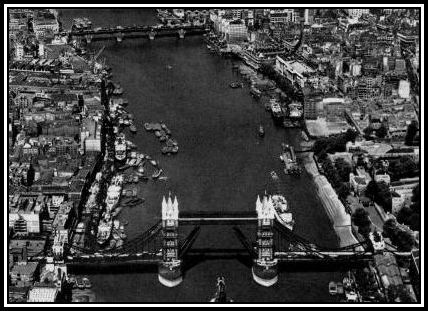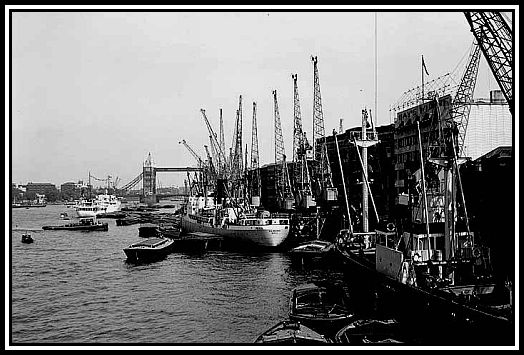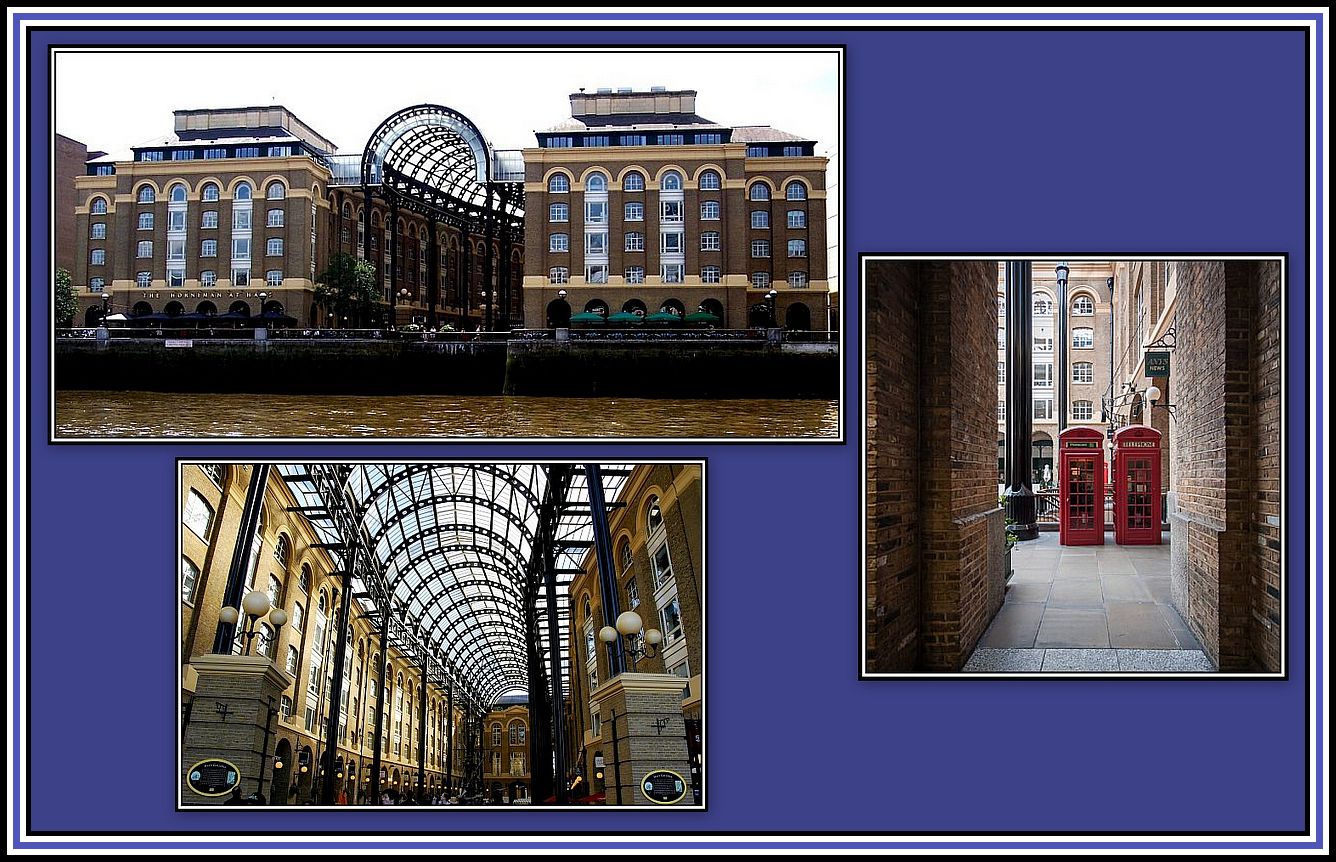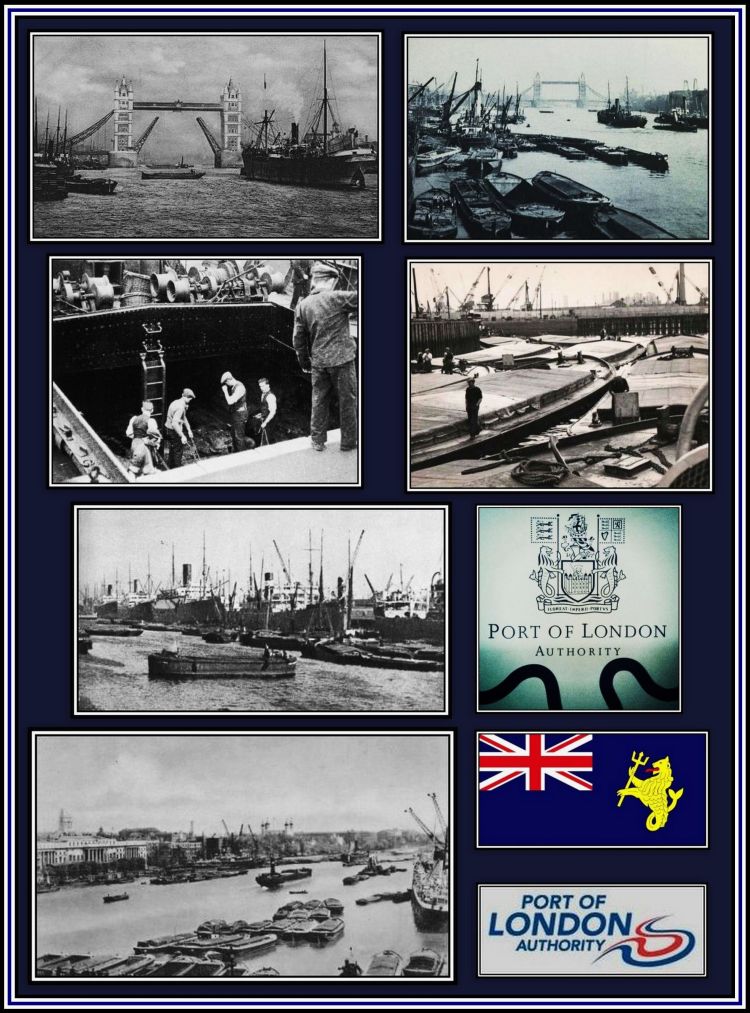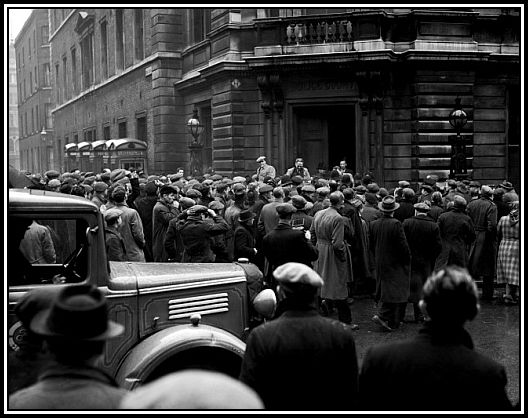MEMORIES
OF
THE TOWER OF LONDON
&
TOWER BRIDGE
-oOo-
PAGE THREE:
THE PORT OF LONDON, DOCKLANDS &
THE ISLE OF DOGS
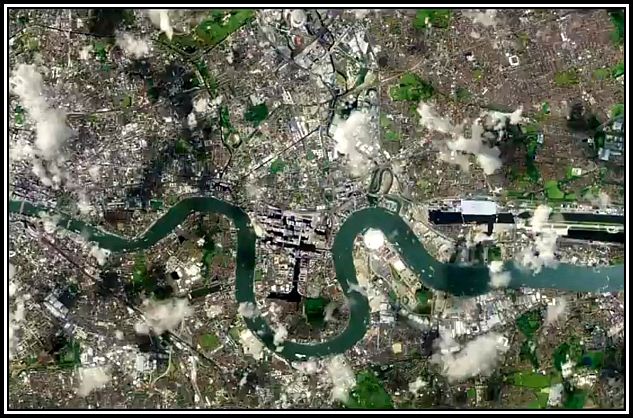 Click here to hear a well-known theme
Click here to hear a well-known theme
-oOo-
THE PORT OF LONDON
The Port of London has been of significance since the establishment of the City in Roman Times. By the 18th Century, it had become the busiest port in the world with Wharves present along the banks of the River for about eleven miles. At its peak, The Port handled over 60,000 vessels each year and, as a result of its prominence, was a major target during The Blitz.
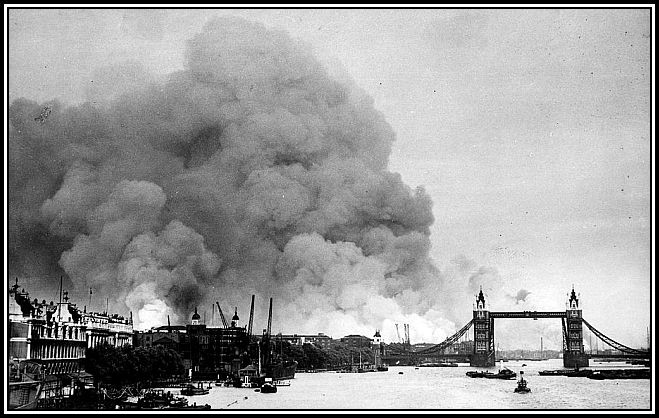 Bombing of The Surrey Commercial Docks in Rotherhithe on 7th September, 1940
Bombing of The Surrey Commercial Docks in Rotherhithe on 7th September, 1940
(This photograph is attributed to the New York Times Paris Bureau Collection and is in the Public Domain and appears at Wikimedia Commons)
-oOo-
The Port of London came into being in the area of the River Thames known as The Pool Of London, which is the stretch of the River that extends from London Bridge to Limehouse.
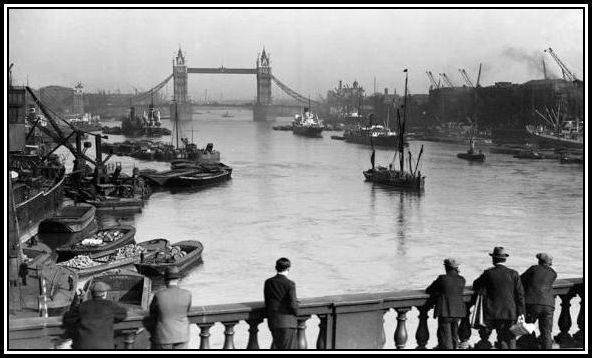 Boats and Barges unloading in the Upper Pool in 1929
Boats and Barges unloading in the Upper Pool in 1929
(This photograph is attributed to Mr. Anake Goodall)
The Pool is divided into two parts:
- the Upper Pool, the section between London Bridge and Cherry Garden Pier in Bermondsey; and
- the Lower Pool. the section from Cherry Garden Pier to Limekiln Creek (The Black Ditch).
The Pool was navigable by tall-masted sailing ships, which brought goods from overseas to London. The goods were stored in wharves especially built along the banks of the River.
-oOo-
THE UPPER POOL & ITS WHARVES
(This photograph is part of that which appears on the cover of the book, The World Around Us)
The company occupying most of the space on the South Bank of the Upper Pool between London and Tower Bridges was The Hay’s Wharf Company. Part of the area was once the site a brew house built in 1651, however wharves have been present in the area since the Middle Ages.
The buildings of Hay’s Wharf seen today were constructed in 1856 by Sir William Cubitt (1785-1861) on the site of an 18th Century wharf. At the Port of London’s most prosperous, 80% of the dry produce imported to London passed through Hay’s Wharf, which resulted in it being referred to as, The Larder of London. Hay’s Wharf was badly damaged by bombing during The Second World War.
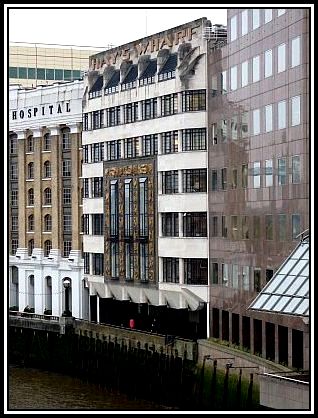 Headquarters of Hay’s Wharf (St. Olaf’s House) built in 1931 adjacent to London Bridge Hosipital
Headquarters of Hay’s Wharf (St. Olaf’s House) built in 1931 adjacent to London Bridge Hosipital
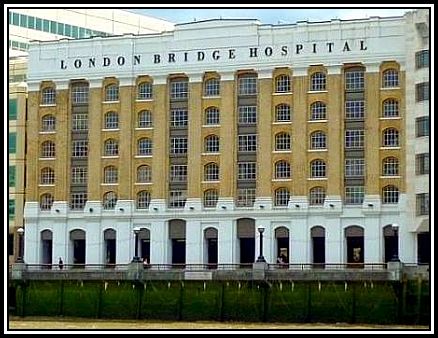 London Bridge Hosipital is a private hospital housed in the former Chamberlain’s Wharf, which eventually became part of Hay’s Wharf in 1925 and was in use until 1969; other independent Wharves that were taken over by The Hay’s Wharf Company were Fenning’s, Sun, Topping’s and Mark Brown’s Wharves
London Bridge Hosipital is a private hospital housed in the former Chamberlain’s Wharf, which eventually became part of Hay’s Wharf in 1925 and was in use until 1969; other independent Wharves that were taken over by The Hay’s Wharf Company were Fenning’s, Sun, Topping’s and Mark Brown’s Wharves
-oOo-
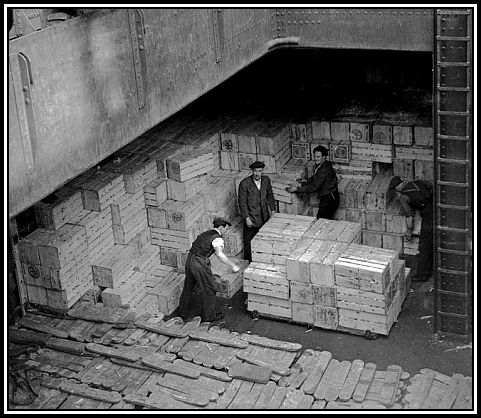 Unloading fruit from a ship docked in The Port of London
Unloading fruit from a ship docked in The Port of London
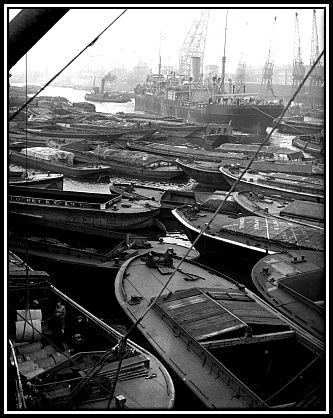 Unloading Barges during The Second World War
Unloading Barges during The Second World War
(These two photographs are attributed to Anorak)
-oOo-
As a result of the closure of The Docks of The Port of London during the 1970s, Hay’s Wharf fell into disuse. By this time, goods were then being transported around the world in containers (i.e. Containerisation) and carried on larger ships that required deeper docks to accommodate them. As a result, London’s docks moved closer to the mouth of the River Thames where deeper waters are found.
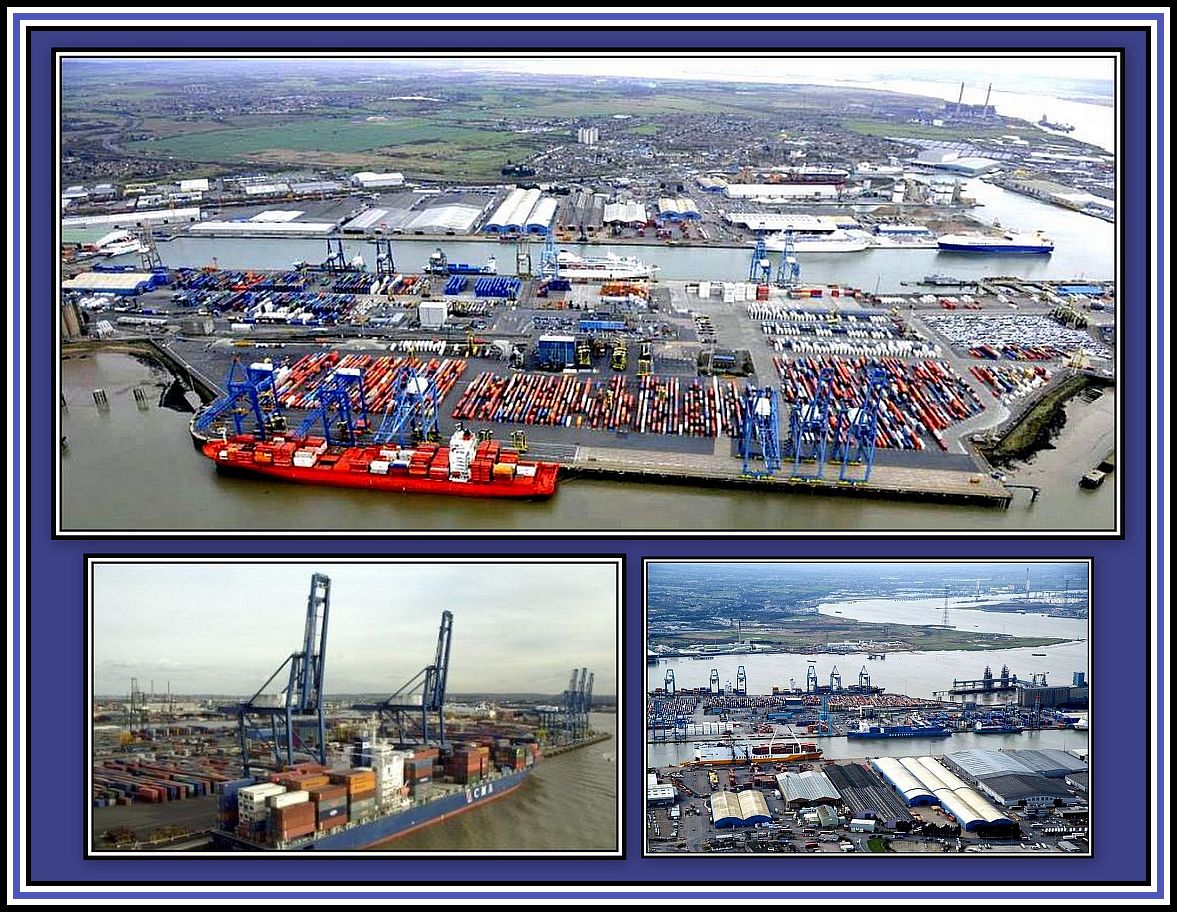 Views of The Port of Tilbury & Docks
Views of The Port of Tilbury & Docks
-oOo-
During the 1980s, the area of the South Bank between Tower and London Bridges was redeveloped as London Bridge City. At this time, Hay’s Wharf was redeveloped and it central area became part of Hay’s Galleria with the dock being retained and the surrounding warehouses converted into flats, shops and offices and the open space being covered by a glass roof. The converted Wharf was opened as Hay’s Galleria in 1987.
-oOo-
It is of interest to note that The Hay’s Wharf Company still exists today, but as Hay’s PLC, which is a Specialist Recruitment Group and operates in thirty-three companies.
-oOo-
Butler’s Wharf was a large wharf on the South Bank of The River just to the east of Tower Bridge. It was built between 1871 and 1873 and contained what was said to be the largest tea warehouse in the world. As with other wharves and warehouses of The Port of London, Butler’s Wharf fell into disuse in the late 1960s and was used for other purposes including a venue for Performance Art and as a setting for a Doctor Who story, Resurrection of The Dalaks. During the 1980s, the then-derelict building was renovated and converted into luxury flats, shops and restaurants.
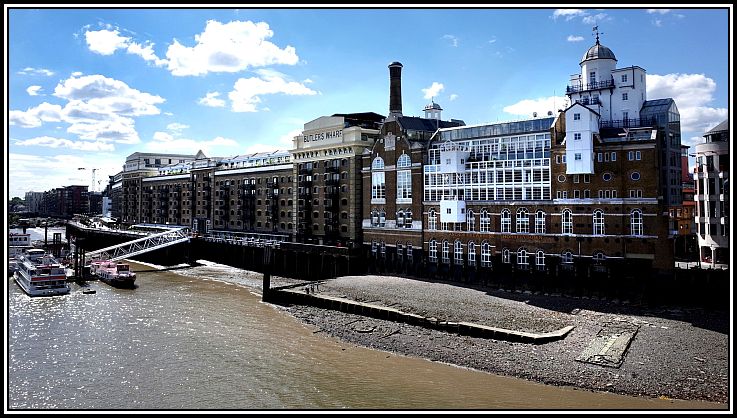 Butler’s Wharf from Tower Bridge
Butler’s Wharf from Tower Bridge
(This photograph is attributed to Oosoom)
-oOo-
A discussion of some of the other Wharves once part of the Port of London may be found by clicking here.
-oOo-
OFF-RIVER DOCKS & THE ISLE OF DOGS
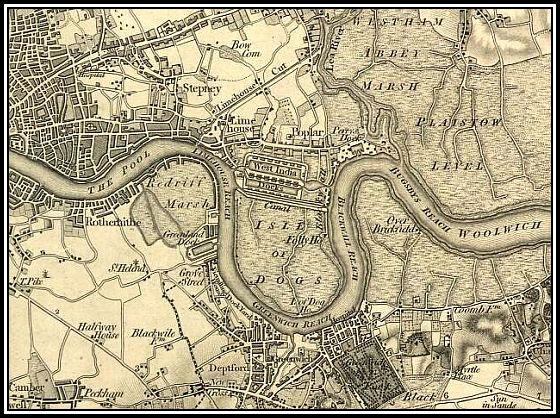 The Isle of Dogs
The Isle of Dogs
With increasing trade, particularly from the West Indies, The Port eventually outgrew the capabilities of The Pool to accommodate the incoming vessels. The demand led to the building of Off-River Docks in the area to the east of The Pool of London, which was commonly referred to as The Isle of Dogs.
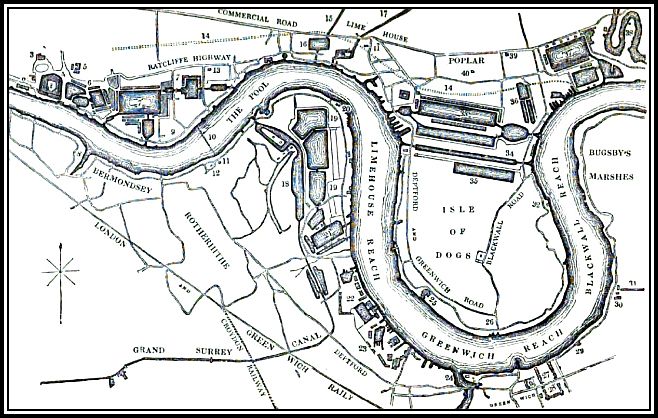 Names given to the River Thames as it flows around The Isle of Dogs
Names given to the River Thames as it flows around The Isle of Dogs
-oOo-
In 1799, The West India Dock Act was passed, which allowed the building of such an Off-River Dock specially for goods from this area. Other enclosed Off-River Docks together with facilities for secure wharves were built soon afterwards.
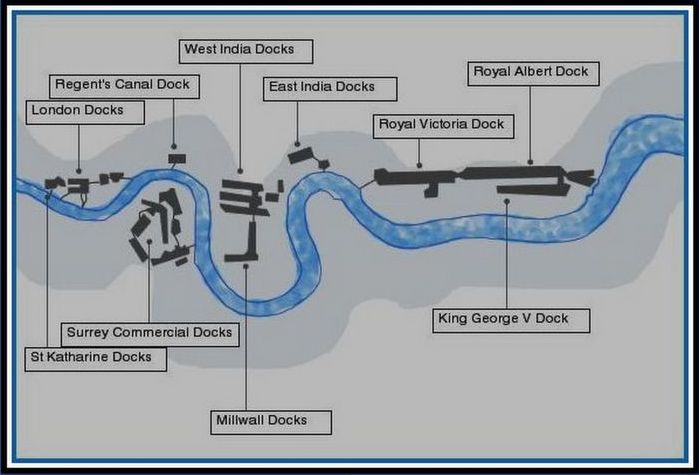 The Enclosed Off-River Docks …….
The Enclosed Off-River Docks …….
……. included:
West India Docks (built in 1802);
East India Docks (1803 and which originated from the Brunswick Dock, 1790);
London Docks (1805);
Surrey Commercial Docks (1807 and which originated from the Howland Great Wet Dock, 1696);
St Katharine Docks (1828);
Royal Victoria Dock (1855;
Millwall Dock (1868);
Royal Albert Dock (1880);
Tilbury Docks (1886); and
King George V Dock (1912).
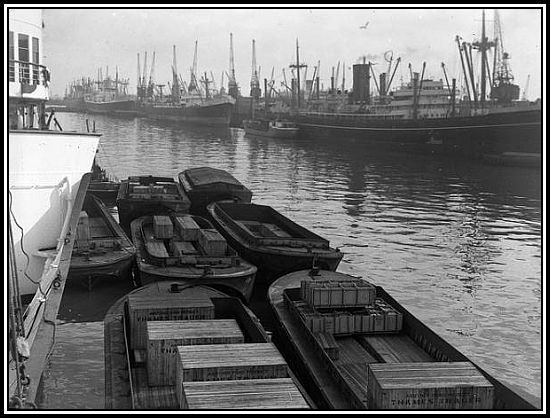 Barges in Royal Albert Dock, 1963
Barges in Royal Albert Dock, 1963
(Photograph attributed to pandosnco.co.uk)
-oOo-
The urbanisation of The Isle of Dogs took place in the 19th century following the construction of the West India Docks, which opened in 1802. This heralded the area’s most successful period, when it became an important centre for trade.
With the building of the Docks, a number of associated industries flourished along side them and included flour and sugar processing together with ship building. On 31st January, 1858 the largest ship of the time, the SS Great Eastern, which had been designed by Isambard Kingdom Brunel, was launched from the yard of Messrs Scott, Russell & Company of Millwall in The Isle of Dogs.
 The Launch of the SS Great Eastern with Isambard Kingdom Brunel present
The Launch of the SS Great Eastern with Isambard Kingdom Brunel present
(This photograph appears on John Speller’s Web Pages – Brunel’s Steamships – SS Great Eastern)
-oOo-
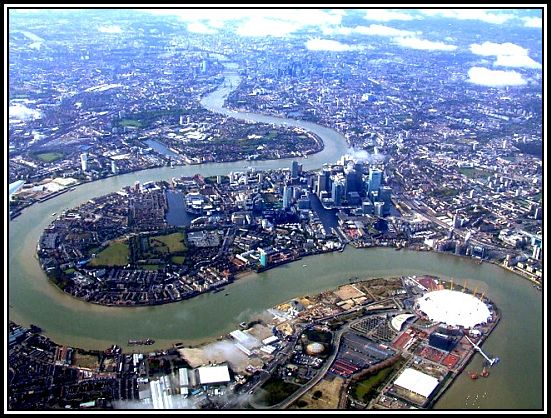 The Isle of Dogs from the air showing The Millennium Dome
The Isle of Dogs from the air showing The Millennium Dome
(This photograph was taken by Thomas Nugent)
-oOo-
The exact origin of the name, The Isle of Dogs, is unclear, but there are a number of theories to account for it. Be that as it may, the area was originally known as Stepney Marsh, but was being referred to as The Isle of Dogs in Panorama of London by Anton van den Wyngaerde (1521-1571) in 1543. However, the name received no official status until 1978, when The Isle of Dogs Neighbourhood was created by the Tower Hamlets Borough Council.
-oOo-
It is of interest to note that The Isle of Dogs is not an Island ……… and has something in common with a description of the nose of Cyrano de Bergerac given in Act One of the play by Edmond Rostand (1868-1918).
 Savinien de Cyrano de Bergerac (1619-1655) was a French novelist, playwright, epistolarian and duelist whose exploits formed the basis of Rostand’s play
Savinien de Cyrano de Bergerac (1619-1655) was a French novelist, playwright, epistolarian and duelist whose exploits formed the basis of Rostand’s play
(The photograph is of an engraving of a painting by Zacharie Heince (1611-1669) and appears at Wikipedia)
Cyrano’s reply to a comment made by the Vicomte (Viscount) de Valvent who had informed him in a bland manner …….
Sir, You have a very big nose!
Cyrano, known for his quick and icy wit, was very aware of the length of his nose and needed no reminding. However, he is picqued at the dullness of the comment and proceeded to deliver a comic monologue filled with descriptions that the Vicomte might have used had he given the matter some thought. The discourse was received with much delight by the on-lookers. One such description of his nose proposed by Cyrano was:
Tis a rock! A peak! A cape!
NO, IT’S A PENINSULA!
Since an Island is an area of land completely surrounded by water, The Isle of Dogs does not fit this definition. In fact The Isle of Dogs is surrounded by water on three sides only, which fulfills the definition of a Peninsula!
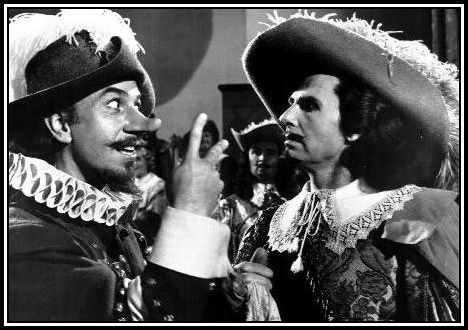 Cyrano de Bergerac, played by Jose Ferrer (1912-1992), and The Vicomte (from the 1950 film)
Cyrano de Bergerac, played by Jose Ferrer (1912-1992), and The Vicomte (from the 1950 film)
-oOo-
The BBC Radio 3 Production of Cyrano de Bergerac from 23rd March, 2008.
The play was translated by Anthony Burgess and with Kenneth Branagh as Cyrano, Jodhi May as Roxane, Tom Hiddleston as Christian & John Shrapnel as De Guiche.
-oOo-
THE FOUNDING OF THE PORT OF LONDON AUTHORITY,
THE DECLINE OF THE DOCKS & THEIR REDEVELOPMENT
With increasing competition and labour unrest, pressure mounted to amalgamate the independent Docks and a Royal Commission was set up in 1908 to investigate their future. This led to the founding of The Port of London Authority (PLA) in 1909 to oversee the running of The Port and this continued until 1992. Since The Port was of great importance to the country, it suffered much during the Second World War and was targeted constantly in the The Blitz.
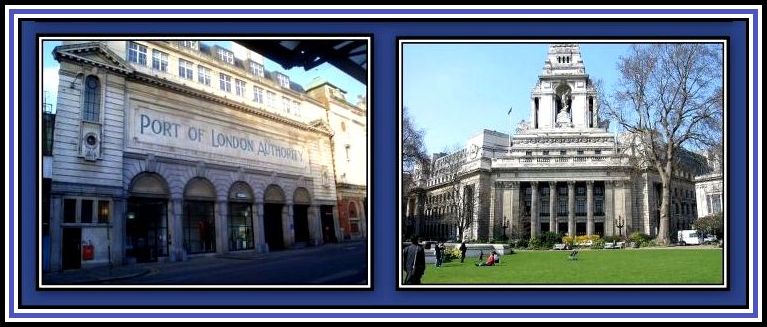 Former Headquarters of The Port of London Authority (PLA)
Former Headquarters of The Port of London Authority (PLA)
During much of its existence, the PLA had its own River Police Force, but today The River is policed by the Constabularies of the Metropolitan, City of London, Essex and Kent.
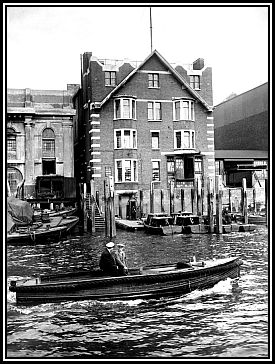 Headquarters of The River Police at Wapping, 1934
Headquarters of The River Police at Wapping, 1934
(Photograph attributed to Anorak)
The River/Marine Police was formed in 1789 and became part of the Metropolitan Constabulary in 1839.
-oOo-
(Photograph attributed to Anorak)
After The Second World War, bigger ships began to be built, which had capabilities that could not be accommodated by the Off-River-Docks. This, together with the introduction of Containers, led to the decline of The Port of London from the mid-1960s onwards and resulted in some Off-River-Dock closure. The threat of closure of The Docks led to much labour unrest resulting in strikes.
This trend continued, and eventually, by the mid-1980s, most of the Off-River-Docks had closed. Although since 1992, the PLA had no longer acted as the operator of The Port of London, it does continue to manage River traffic.
Closure of the Off-River–Docks led to large areas of disused land requiring redevelopment and a huge number of unemployed workers requiring jobs. During the 1970s, successive governments put forward a number of proposals for the redevelopment of the area, but it was not until 1981 with the founding of the London Docklands Development Corporation and the granting of Enterprise Zone in 1982 that redevelopment began in earnest.
Since the closure of the Docks, part of the area has been redeveloped for housing and a number of the wharves lining the River have been converted into apartments, shops and restaurants.
-oOo-
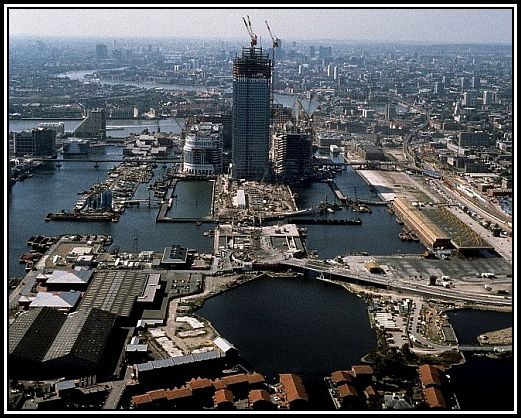 Conversion of The West India Docks into Canary Wharf (1990)
Conversion of The West India Docks into Canary Wharf (1990)
(Photograph attributed to Anorak)
Canary Wharf is the area of Docklands built on what was once the former West India Docks at The Isle of Dogs. This is the site where London’s Second Financial District has been set up and is now home to the Head Offices of a number of multinational companies.
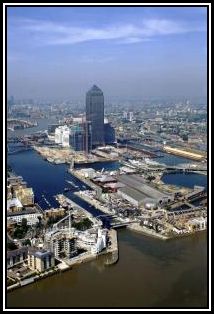 Canary Wharf in 2001
Canary Wharf in 2001
Between the early 1980s and 2005, most of the Fleet Street Newspapers re-located to Wapping and Canary Wharf. Rupert Murdoch built a new printing and publishing works, News International, in Wapping in 1986 despite protests from print workers. Mr. Murdoch intorudced the new printing technology at his new installation, which resulted in some 5,000 print workers being made redundant. The loss of jobs led to the workers laying siege to the building, but they failed in their hope of getting their jobs back.
Although it would seem that London Docklands is a success story, and in part, it is, however, there are still problems with its development. In 2005, Murdoch announced that he was moving his printing operation out of Wapping and planed to redevelop the unused space. Also, in 2008, The Independent group of publications announced that it would move its offices back into central London.
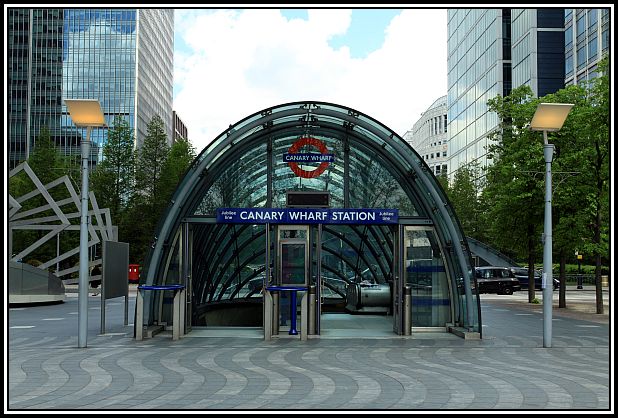 Canary Wharf Underground Station on the Jubilee Line and opened in 1999 and is now one of London’s most used stations
Canary Wharf Underground Station on the Jubilee Line and opened in 1999 and is now one of London’s most used stations
Canary Wharf has also been served by Docklands Light Railway (DLR) since 1989
-oOo-
I suppose that it is less than gracious of me to complain about the modern Port of London and The Isle of Dogs, but ……….. !
I appreciate that living conditions of these areas of East London were not exactly healthy for its inhabitants. It seemed to me, even as a child, that every other area of London was being rebuilt while the East London languished in bomb sites, poor housing and a lack of management. It seemed to me that the rebuilding and renovation of the East End and East London in general had to wait until the mid-1960s before it recovered fully from The Second World War.
The loss of Docklands was disastrous to Cockneys like me. In many ways I was lucky, as we were rehoused and banished to darkest Buckinghamshire and made to live in a new home and to breath fresh air in 1956! As a result of moving from Bethnal Green, I was spared the witnessing of the the renovation and rejuvenation that came upon the East End. Visits to the area allowed me to see changes once they had happened. Luckily, I did not have to live with them and suffer their direct consequences. I thank heaven each day that I was spared The Gentrification of Bethnal Green!
Canary Wharf with its desperate sky scrappers reminds me of that miserable area to the west of Paris, La Defense, which successive French politicians seemed to be so proud of. Both are poor monuments to commerce and are symbols of what the modern world now glorifies.
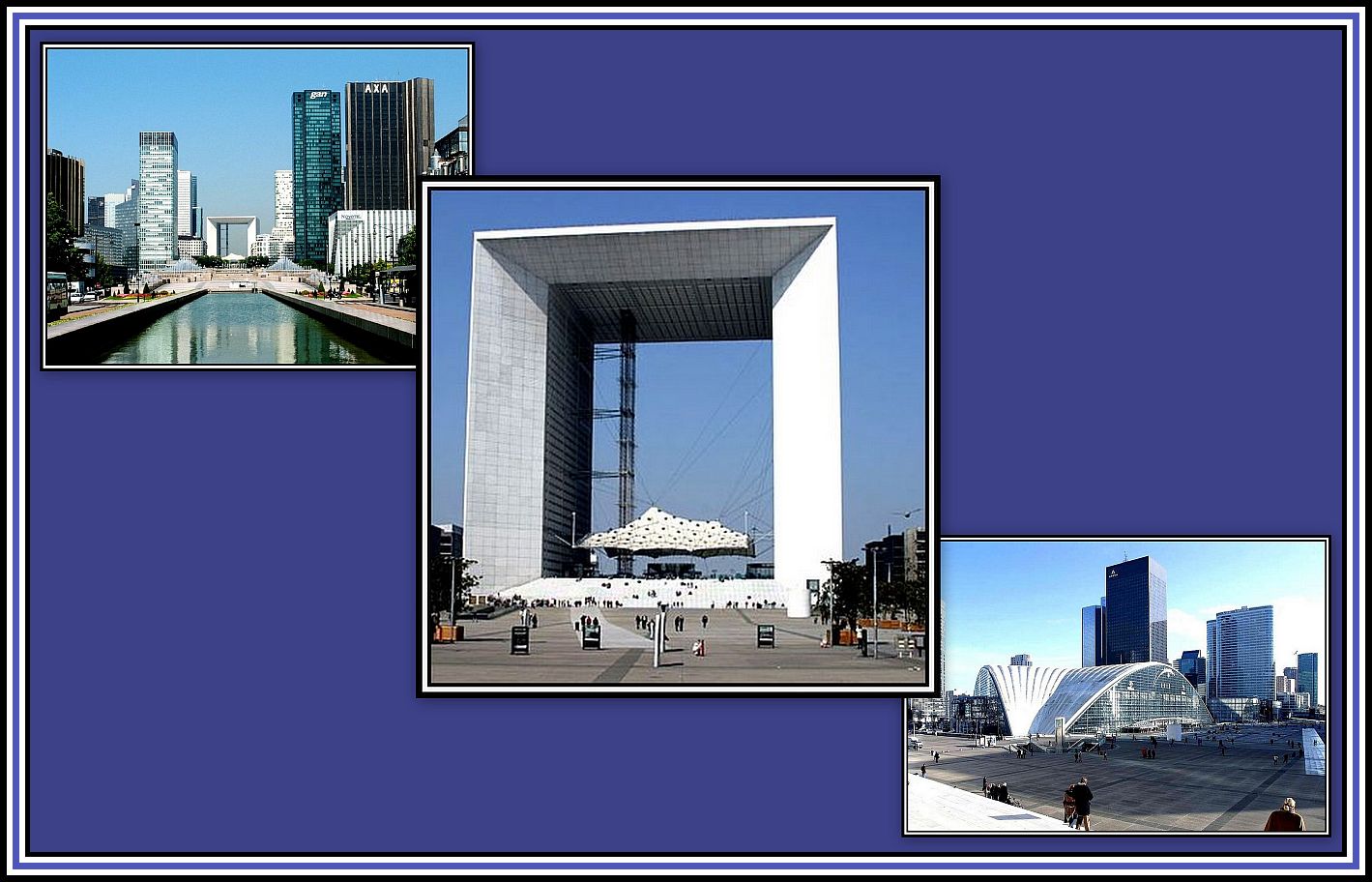 La Grande Arche de La Defense/The Grand Arch of La Defense
La Grande Arche de La Defense/The Grand Arch of La Defense
But enough of my complaints! Time marches on, as it is said, and change is not only inevitable, but necessary for progress to occur. As the comedian, Al Reid (1909-1987), used to say, Such is Life! It isn’t that I am against change. I only wish that change would occur with a little more style!
——oooOOOooo——
ACKNOWLEDGEMENTS
I would like to thank those that allowed their photographs to appear here.
——oooOOOooo——
——oooOOOooo——
——oooOOOooo——
Click here to GO to the POPPIES AT THE TOWER – PAGE 4
——oooOOOooo——
Click here to GO to the POPPIES AT THE TOWER – PAGE 3
——oooOOOooo——
Click here to GO to the POPPIES AT THE TOWER – PAGE 2
——oooOOOooo——
Click here to GO to the POPPIES AT THE TOWER – INTRODUCTION
——oooOOOooo——
Click here to RETURN to the TABLE OF CONTENTS
——oooOOOooo——

